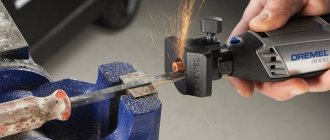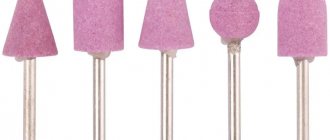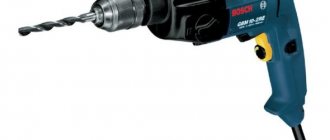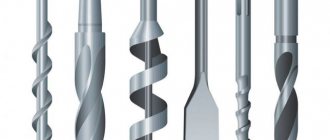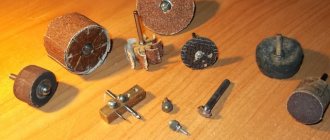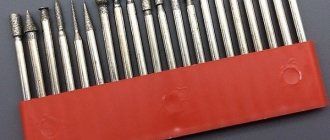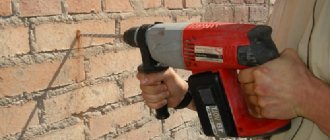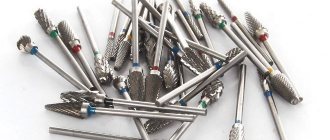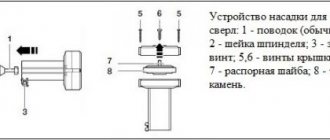A flexible shaft, the main purpose of which is to transmit torque over a considerable distance, is most often used to equip engravers. This type of equipment, which is essentially a miniature grinding machine, is actively used for processing small-sized parts. In particular, the engraver is used as a mini-drill; it is used to perform miniature cutting, selective grinding of small elements of products and a whole list of other works.
The flexible shaft simplifies the use of the engraver, eliminating the need to hold the tool above the work site
The most common areas where flexible shaft engravers are used are the jewelry and electronics industries. Such equipment is actively used by design specialists, employees of car repair stations and workshops involved in the repair of household appliances and electronic equipment.
An electric engraver, on which a flexible drive is installed, is especially relevant in situations where processing must be performed in hard-to-reach areas of the product. Using replaceable attachments, such equipment can be used in all stages of processing, from roughing to finishing.
Flexible engraver shaft with protective springs at the ends that protect the rubber casing from damage
What operations are performed using an engraver with a flexible drive?
Special attachments help turn an engraver with a flexible shaft installed on it into a truly universal device, which include:
- grinding and polishing wheels, allowing you to bring the surface of the workpiece to a perfectly smooth state;
- brushes used for cleaning the surface of the product and polishing it in hard-to-reach places;
- cutting wheels for cutting products and processing their torn edges;
- drills, with the help of which the device turns into a miniature drill;
- cutters and abrasive wheels that allow processing of products in hard-to-reach places;
- pen-shaped attachments used for engraving work.
To ensure ease of operation with such a device equipped with a flexible drive shaft, you can purchase additional accessories - rubber grips on the handle, a power button lock, etc.
All kinds of holders are very useful, in which, in addition to the shaft and the engraver, you can attach various attachments
Engravers on which a flexible drive shaft is installed also include a drill used in dentistry, a manicure machine, equipment for processing natural stone and applying inscriptions and drawings to the surface of products made from it.
You can also use a flexible shaft for a drill or purchase a flexible shaft for a screwdriver. With this improvement to conventional power tools, a screwdriver attachment or drill can be successfully used to perform work even in the most difficult to reach places.
Make your own flexible shaft for a drill
The cost of a high-quality device is high, especially considering the fact that if the product needs to be used, it will be in a one-time quantity. To avoid having to buy one, you can easily make a flexible shaft for your drill yourself.
To make flexible shafts for drills with your own hands, you will need to take any braided wire. It can also be purchased, which will cost ten times less than buying a ready-made nozzle. If you plan to wind a spiral wire around the cable yourself, then you need to understand that it is impossible to do this at home. After all, armor steel is used as a spiral base. When such a device operates, the steel cable rotates inside the shell, and the armor in the form of a spiral wire bends in any position, but does not move. During operation, the device is held by hand by the spiral wire.
This is interesting! To make a homemade device, a speedometer cable from a car or motorcycle available in the garage is suitable.
Finally, a shank is made for the flexible shaft, which is installed in the drill chuck. To do this, use the tail part of a damaged drill. The cable is connected to the shank by welding (other connection methods are unacceptable). A collet chuck is attached to the other end of the wire, which can be taken from another power tool. There are quite a lot of advantages to a homemade flexible shaft for screwdrivers and drills, but the most important thing is its low cost. Having used such a nozzle once for work, you can find out what its main advantage is and why manufacturers came up with this device. The ease of making an attachment in the form of a flexible shaft for a drill yourself makes it more interesting to make it yourself than to buy it on the Internet or a tool store.
How does the engraver work and how does it work?
The engraver, which allows you to process parts with high precision and productivity, works on the principle of a conventional drill, and in appearance it is very similar to a large automatic pen. The main structural elements of such a device are:
- engine;
- a flexible drive shaft that transmits torque from the engine to the working attachment;
- gearbox;
- a fan used to cool the spindle;
- the spindle itself with a protruding working part;
- device body with special openings for the exit of heated air;
- a nut designed to fix the used nozzles;
- device power regulator;
- lock button;
- power switch;
- hook for hanging the switched off device.
Engraver device
Rotation from the engine is transmitted to the axis of the flexible shaft, the reverse side of which is connected to the working nozzle. The mounting locations of the nozzles are unified, so there are no problems with choosing the required tool and replacing it.
Equipment selection criteria
When choosing an engraver, you should focus on a number of characteristics.
Power
Based on the power level of the device, on which its performance directly depends, one can indirectly judge the operating life of the drive motor. The power of the engraver, which for serial models can be in the range of 35–300 W, should be selected based on the tasks for which it is planned to use such equipment. In addition, you need to consider how long it will work between turning on and off. The duration of the operating process depends on the hardness of the material from which the product being processed is made. The longer the engraver is used at one time, the more power it should have.
The low-power compact engraver is suitable for simple work without a flexible drive
Number of revolutions
The speed at which the electric motor shaft and the flexible drive shaft attached to it rotate is also selected depending on the hardness of the materials that need to be processed using the engraver. Models offered on the modern market can provide tool rotation speeds in the range of 10–35 thousand rpm. Low-speed models can be purchased if they will be used primarily for finishing grinding and polishing. When performing such operations, a small load is placed on the tool, so the engraver itself does not overheat, and therefore does not fail.
If you need a more universal device with a flexible shaft, it is better to give preference to engravers that provide the ability to adjust the rotation speed of the tool.
The speed controller significantly increases the functionality of the engraver.
Dimensions and weight
The weight and dimensions of the engraver affect how convenient and easy it will be to manipulate such a device during processing with its help. Engravers that have significant dimensions and weight are much more difficult to work with, but such devices, as a rule, have higher power and productivity. The weight of an engraver with a flexible drive shaft can be in the range of 0.5–8.5 kg. When choosing such a device, first of all take into account the required power and functionality, and only then pay attention to the weight and dimensions.
Ergonomics
Since an engraver works by constantly holding such a device in his hands, its ergonomics, which characterizes the ease of working with the equipment, is an important factor when choosing. When assessing the ergonomics of a device, you should pay attention not only to its design, but also to the build quality, manufacturing materials, button placement and comfortable handle design.
Before purchasing a tool, you should hold the engraver in your hands, test the activation of buttons and latches
Level of noise, vibration and heating
These parameters are not indicated in the equipment passport. It is advisable to pay attention to them if the engraver will be used quite often. To evaluate how much noise and vibration the device makes during operation, you just need to turn it on and evaluate these parameters. As a rule, medium-power engravers make more noise, and in more high-speed equipment this problem is provided for by the manufacturers and is eliminated by including special elements in the design. You can only estimate how hot an engraver equipped with a flexible drive shaft gets during operation.
Flexible shaft design
A flexible shaft for an engraver or any other equipment whose torsional rigidity has higher requirements than bending rigidity, as mentioned above, is used to transmit torque to elements that change their spatial position during operation.
The main part of the flexible shaft, which is responsible for the main function of such a device, can be a wire rod or a special cable. This element is made of materials with high torsional rigidity. Additional layers of twisted wire are wound onto the main core of the flexible wire shaft to give it higher rigidity. To ensure safe use of the flexible drive shaft, as well as to protect its surface from damage and retain lubricant on it, this device is placed in a flexible protective shell, which is stationary in relation to the rotating core.
This flexible shaft is equipped with a bit holder on one side and a union nut on the other to secure it to the engraver.
Depending on the design, flexible shafts can be of right or left rotation, which should be taken into account when selecting and using them. Not only the design of flexible shafts can be different, but also their length, sometimes reaching five meters.
The design of the fastener for such a device also depends on where the flexible shaft is installed - on a drill, engraver or screwdriver. Thus, fastening nuts or other types of fastening fittings can be placed at the ends of the shaft.
The tip of this shaft can be removed for cleaning and lubrication, for which there is a hole on the side
Various mechanisms and equipment are driven by flexible shafts of different designs. In addition to engravers, drills and screwdrivers, internal vibrators, brush cutters and many other types of technical devices are equipped with such shafts. The simplest and most familiar option for using a flexible shaft is to clear sewer pipes from internal blockages.
Mechanical car speedometers are also driven by a flexible shaft. Making a flexible shaft with your own hands is, of course, possible, but given the loads under which such a device operates, it is better not to experiment and purchase serial products from trusted manufacturers. You can only be puzzled by the issue of making a flexible shaft yourself if it will be used to drive low-power equipment operating at low speeds.
Why do you need a flexible shaft for a drill?
The design of the product in question is quite simple, but despite this, the device is multifunctional. The flexible drive consists of two elements: a cable with an armored base and a soft body. On one part of such a nozzle there is a special tip, with which the shaft is secured in the chuck of a screwdriver or drill.
The second part, in which the bits are fixed, is equipped with a cartridge or a special retainer for replaceable bits. The presence of a chuck on a flexible shaft for drills allows drills and other types of attachments to be secured in the structure of the device. Such equipment is used in medicine, or more precisely, in the field of dentistry. With the help of the products in question, the functioning of drilling machines is ensured, with which holes are drilled in teeth for installing fillings. There is a factory-made flexible shaft for sale for a mini drill engraver, which is used by craftsmen who repair electronics, watches and other small devices. A flexible shaft for a drill is rarely used in construction, but without it, sometimes it is simply impossible to get to the fastening element in order to tighten it or unscrew it. Cases where a flexible shaft on a power tool is indispensable include times when there is no direct access to carry out work with a drill or screwdriver. The nozzle in question allows you to carry out various types of work:
- Drilling holes in wood, concrete and metal
- Grinding and cleaning of parts
- Screwing in and out of various screws and screws
Using a nozzle (also called a “flexible spiral” or “guta-percha extension”) for drilling holes in concrete or metal is not entirely convenient, since this will require a reliable stop, which a useful device cannot provide due to its design features.
This is interesting! An attachment called a flexible shaft can be used not only on drills or screwdrivers, but also on an angle grinder. However, you need to be extremely careful and attentive with this tool. After all, the spindle rotation speed reaches 11,000 rpm, so you need to work with the use of personal protective equipment.
